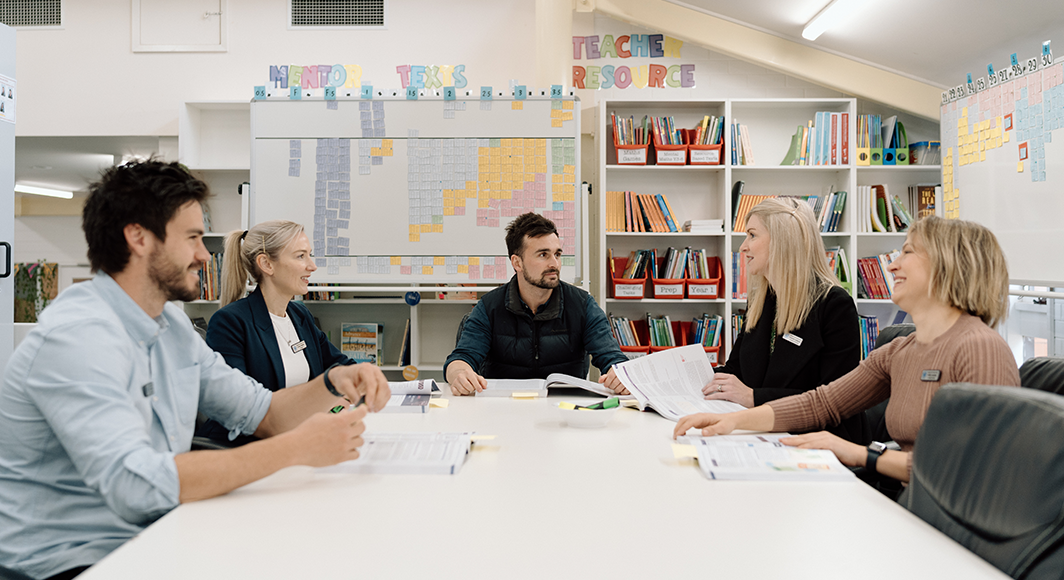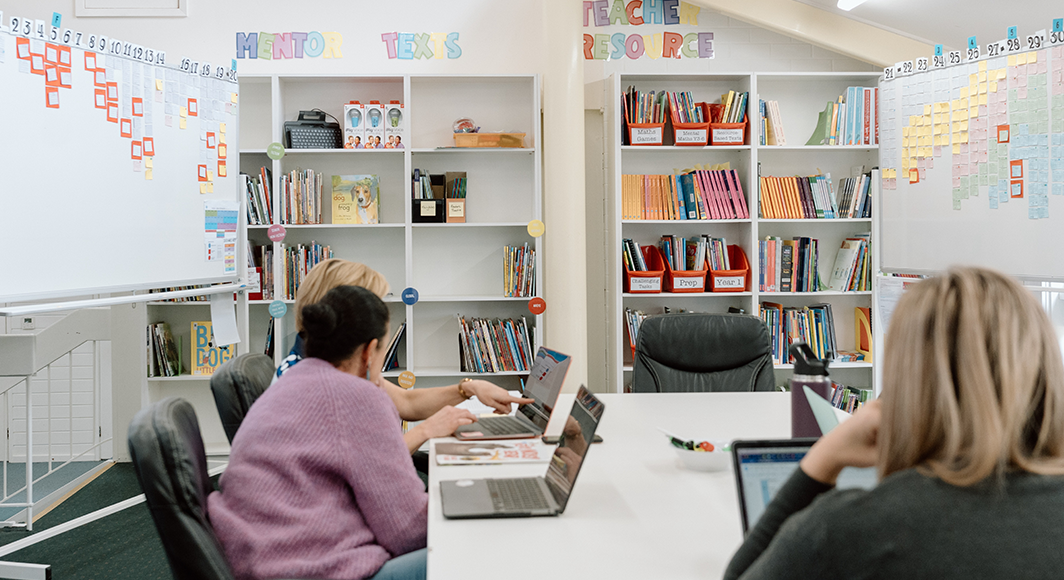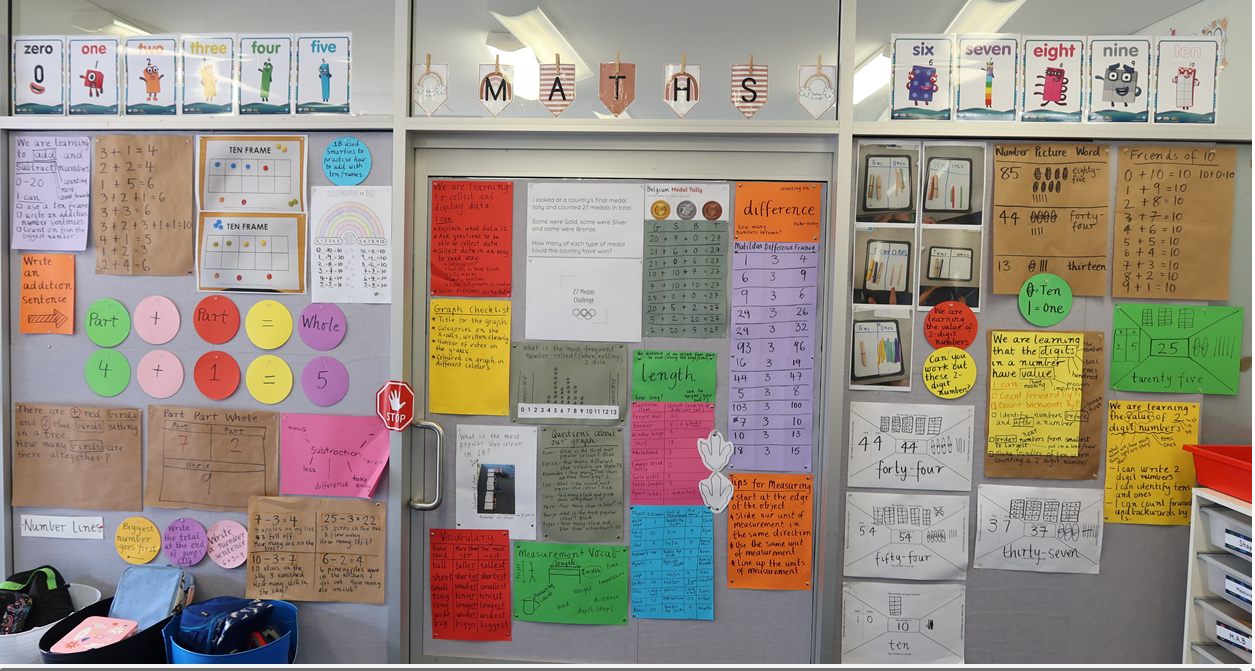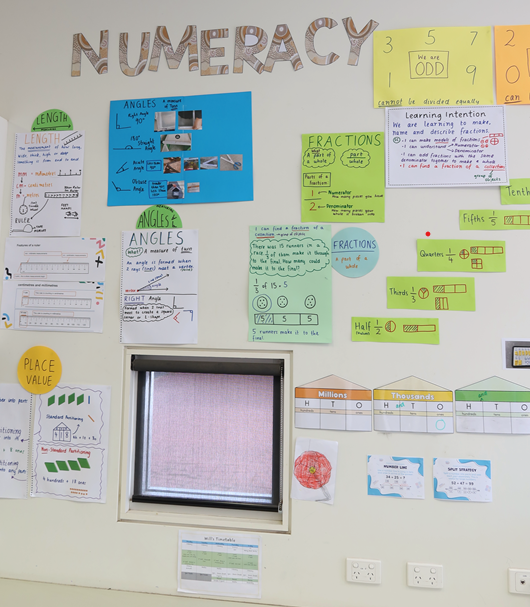Published 28 Aug 2024
Establishing confidence and capability with collaborative planning – Wangaratta West Primary School
Engaged with colleagues, school and the broader community
Kristy Mullins – Principal
Wangaratta West Primary School
Schools and early childhood services across Victoria continue to provide quality learning experiences across all levels. The VIT’s Professional Practice team is privileged to see this work first-hand on visits to workplaces around the state. This is just one example showcasing the great work happening in a Victorian school.
The vision of Wangaratta West Primary School is to create learners for life who care for themselves, others and the environment. The leadership team, including Principal Kristy Mullins, identified that leaning on their strong emphasis of relationship-building, they could rethink their approach to planning to ensure their team and learners had the best chance to thrive.
We spoke to Kristy about the benefits of collaborative planning, and the ways in which the Wangaratta West team have developed from their new approach and refreshed learning environments.
Q: Can you provide some background to your approach in developing the initiative, including any research or established models / strategies that your approach is based upon?
For collaboration to be most effective, a positive culture built on respect, appreciation and trust in colleagues is in my opinion crucial, so relationships have been a key focus for our team at Wangaratta West Primary School. We believe the formula for our success has been creating a supportive atmosphere for staff through quality connections and promoting a strong sense of inclusion and voice. When staff feel valued, heard, and actively involved in decision making, a likely outcome is increased sense of professional fulfillment and commitment. In turn, this fosters a positive staff culture.
Having happy staff improves the likelihood of happy students, so the impact is twofold. We have worked hard to create a calm learning environment where students feel safe and cared for. At the same time, we are constantly striving to promote connection with families so that they feel informed and valued as an integral part of their child’s education.
For us, the transformation began with the development and implementation of a whole-school planning process. This has been the catalyst for positive change through increased collaboration, consistency and quality of lessons being prepared and delivered. We started by adjusting the specialist timetable so that teaching teams have dedicated time together within the day for collaborative planning. This enables teachers to meet and learn from one another, coming together to develop high quality lessons and sequences of learning supported by a middle leader who acts as a ‘knowledgeable other’. Alongside it, we developed a collaborative planner structured with key elements of our instructional model which is regularly revisited and updated based on current research, ensuring we are delivering knowledge rich and low variance curriculum to our learners.
We then carved out a further hour within the timetable to establish Professional Learning Communities (PLCs), supported by a middle leader. This further extends our dedication to ongoing professional growth and a systematic, data-based approach to needs-based, targeted teaching and learning. These two opportunities for staff to meet within the week are purposeful, efficient and considered crucial, thus the time is protected each week.

Collaborative planning sessions at Wangaratta West Primary School

Collaborative planning sessions at Wangaratta West Primary School
Q: What structural things are in place to ensure that the initiative has its best chance of success?
The ‘Using Evidence for Impact’ publication guided our strategic thinking in relation to resource management and changes to structures and procedures within the school. The publication presents evidence of impact across schools in Victoria and highlights four key decision points across the School Improvement Cycle at which a specific critical decision point is introduced to illustrate the actions that best support school improvement. Each stage also highlights actions for your school improvement team, key connections, capability checks and resources.
Creating a designated space within the school for collaborative planning / PLC was pivotal to success. The area is designed for purpose and includes data walls, professional texts and anchor charts depicting the instructional model used within the school and technology to support collective planning.
A focus on strategically designed learning then transpired, with a reimagining of classroom wall design to scaffold learning. We incorporated Lyn Sharratt’s “Third Teacher” where students access support in their learning through visual displays of learning intentions, anchor charts and support. This included consultation from experts including an occupational therapist to avoid overstimulating visual displays. We decided to strip classroom walls, repaint them and strategically and incrementally rebuild learning walls that feature intentional and designated literacy, numeracy, and inquiry walls, serving as additional teaching resources. The resources featured on these walls are predominantly handmade anchor charts that have been created collaboratively with students and are updated regularly in order to support student independence and make learning accessible.
An important element of leading these whole-school changes has been the introduction of avenues for staff voice including implementation of an anonymous survey conducted once a term. This survey allows us to gather candid feedback from our staff, providing insights into what is working well and which areas need improvement. This feedback is essential, as it helps us identify where further changes are needed to enhance our school environment.
After collecting the survey responses, my team and I review and identify key areas that require attention, with findings then presented back to the staff. For suggestions that we can implement immediately, I work with the staff to put these ideas into action. For those that require further exploration, we discuss their feasibility and potential impact before making any decisions. This dialogue ensures that everyone's voice is heard and considered. There are times when certain suggestions may not be possible due to various constraints. In these cases, we explain clearly why we cannot move forward with those ideas. This transparency builds trust and helps everyone understand the broader context of our decision making.

Classroom wall at Wangaratta West Primary School

Numeracy wall at Wangaratta West Primary School
Q: What are the greatest benefits to staff development of this approach?
The focus on collaboration and collective responsibility has been central to our staff’s continued learning and development and a positive shift in student learning across the board. The release of our school’s middle leaders (Learning Specialist and Leading Teacher) has played an important role in this. By facilitating and guiding collaborative planning and PLC sessions, our leaders are guiding the ongoing professional learning of staff aligned to both individual team needs and the school’s priorities. Over time, staff have expressed increased confidence in data literacy, action research, curriculum knowledge and teaching strategies. The willingness of staff to embrace change is also clearly evident. I have the privilege to lead a staff that is trusting, optimistic, and willing to give new approaches a go with the belief that change will be based on current knowledge of best practice. They also believe such changes will likely result in improved outcomes for students and will be heavily supported by the leaders of the school, with their own expertise and guidance supporting continuous improvement and confidence.
Staff culture and collaboration has risen significantly over the years as evidenced within the annual staff opinion survey. We genuinely trust, care for and respect one another, celebrating our successes as a group, and facing challenges together. When things do not go as planned, we come together to address and learn from these setbacks. We are a cohesive group whose consideration for one another goes far beyond collegiality. Protecting this special culture that the staff has built together is paramount and sits behind all decision making, particularly when change is involved.
Q: What have been the benefits to learner outcomes of this approach?
The process of creating consistency has been gradual but has certainly proven beneficial to helping achieve the much-discussed goal of a guaranteed and viable curriculum. We are now confident that learners in each class are being exposed to the same curriculum albeit in slightly different ways as we are conscious not to stifle the creativity and individuality of teachers. The initiative has succeeded thanks to the commitment of our staff combined with the expertise of the leaders at our school - our two Assistant Principals, Leading Teacher and Learning Specialist. These outstanding practitioners lead from the head and the heart, utilising extensive educational research to inform decisions alongside observations and feedback from staff, and they continually strive for better ways of working in order to best support our students.
Implementing structures to support quality collaborative planning and PLC meetings has also allowed us to roll out changes to our literacy and mathematics approach in an effective, supported and efficient manner.
We saw the benefits of our new approach in action earlier this year when we introduced a new literacy model that goes beyond traditional reading and writing, with a focus on explicit phonics instruction based on the work of Jocelyn Seamer. This model has been intentionally embedded into our teachers’ instructional practice. Our curriculum leadership team, comprised of an Assistant Principal and Leading Teacher, worked together to design a whole school approach complete with a suite of curriculum plans and resources to support a smooth transition from a soft launch of our literacy model to full implementation. Our Leading Teacher and Learning Specialist then worked with staff during collaborative planning and PLC meetings respectively to discuss, trial, workshop and tweak the models in order to best support implementation. This wrap-around approach has seen a swift uptake, with the model well-received by staff and parents who have given positive feedback, noting improvements in students’ literacy skills. It is also proving especially beneficial for supporting learners who may have missed out on early literacy experiences.
Similarly, over recent years we revitalised our numeracy instruction using a similar approach, adopting Jo Boaler’s growth mindset principles and emphasising the belief that everyone can learn Maths. This approach encourages positive self-talk, affirming language and viewing of mistakes as part of the learning process. By fostering an environment where students feel comfortable to try, fail and learn we are fostering a safe space for curiosity, growth and development. This is proving particularly successful in addressing a lack of mathematical self-confidence in our senior female students, evident in poor self-talk and survey data. By focusing on solving problems in multiple ways, celebrating creative thinking and fostering enjoyment, we are working towards bolstering learners who see themselves as successful mathematicians who can see the relevance of mathematics to their lives within and beyond the classroom.
Q: What plans does your workplace have to take this approach forward?
As a leadership team and staff, we are continuing to face a broad range of challenges, from the vast array of literacy and numeracy skills and abilities within each classroom, to issues of disadvantage and trauma. We are constantly striving to cater to the wide-ranging needs of students within each class by working collectively to put appropriate systems and structures in place that support all learners to thrive and succeed. This includes a focus on closing the gap with targeted interventions led by the right people and increasing our understanding of neurodivergence in order to provide the necessary supports that extend and enhance each student's learning experience.
Q: Can you detail any references or citations applicable?
- Using evidence for impact – Victorian Department of Education
- Jo Boaler’s Growth Mindset principles – YouCubed, Stanford Graduate School of Education
- Lyn Sharratt Complete Collection – Dr Lyn Sharratt, Australian Council for Educational Leaders
- Explicit teaching – Jocelyn Seamer Education.
Do you have an example of outstanding work in your school or early childhood service? We’d like to consider showcasing it the Excellence in Teaching section of our website. Send your example and contact details to vitcomms@vit.vic.edu.au.
